The leucine-rich repeats in allelic barley MLA immune receptors define specificity towards sequence-unrelated powdery mildew avirulence effectors with a predicted common RNase-like fold
- PMID: 33534797
- PMCID: PMC7857584
- DOI: 10.1371/journal.ppat.1009223
The leucine-rich repeats in allelic barley MLA immune receptors define specificity towards sequence-unrelated powdery mildew avirulence effectors with a predicted common RNase-like fold
Abstract
Nucleotide-binding domain leucine-rich repeat-containing receptors (NLRs) in plants can detect avirulence (AVR) effectors of pathogenic microbes. The Mildew locus a (Mla) NLR gene has been shown to confer resistance against diverse fungal pathogens in cereal crops. In barley, Mla has undergone allelic diversification in the host population and confers isolate-specific immunity against the powdery mildew-causing fungal pathogen Blumeria graminis forma specialis hordei (Bgh). We previously isolated the Bgh effectors AVRA1, AVRA7, AVRA9, AVRA13, and allelic AVRA10/AVRA22, which are recognized by matching MLA1, MLA7, MLA9, MLA13, MLA10 and MLA22, respectively. Here, we extend our knowledge of the Bgh effector repertoire by isolating the AVRA6 effector, which belongs to the family of catalytically inactive RNase-Like Proteins expressed in Haustoria (RALPHs). Using structural prediction, we also identified RNase-like folds in AVRA1, AVRA7, AVRA10/AVRA22, and AVRA13, suggesting that allelic MLA recognition specificities could detect structurally related avirulence effectors. To better understand the mechanism underlying the recognition of effectors by MLAs, we deployed chimeric MLA1 and MLA6, as well as chimeric MLA10 and MLA22 receptors in plant co-expression assays, which showed that the recognition specificity for AVRA1 and AVRA6 as well as allelic AVRA10 and AVRA22 is largely determined by the receptors' C-terminal leucine-rich repeats (LRRs). The design of avirulence effector hybrids allowed us to identify four specific AVRA10 and five specific AVRA22 aa residues that are necessary to confer MLA10- and MLA22-specific recognition, respectively. This suggests that the MLA LRR mediates isolate-specific recognition of structurally related AVRA effectors. Thus, functional diversification of multi-allelic MLA receptors may be driven by a common structural effector scaffold, which could be facilitated by proliferation of the RALPH effector family in the pathogen genome.
Conflict of interest statement
The authors have declared that no competing interests exist.
Figures
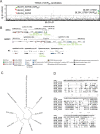
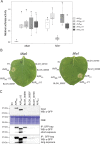
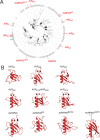
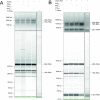
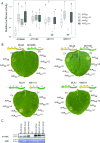
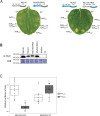
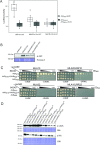

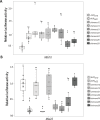
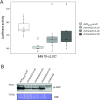
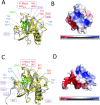
Similar articles
-
Allelic barley MLA immune receptors recognize sequence-unrelated avirulence effectors of the powdery mildew pathogen.Proc Natl Acad Sci U S A. 2016 Oct 18;113(42):E6486-E6495. doi: 10.1073/pnas.1612947113. Epub 2016 Oct 4. Proc Natl Acad Sci U S A. 2016. PMID: 27702901 Free PMC article.
-
Multiple pairs of allelic MLA immune receptor-powdery mildew AVRA effectors argue for a direct recognition mechanism.Elife. 2019 Feb 19;8:e44471. doi: 10.7554/eLife.44471. Elife. 2019. PMID: 30777147 Free PMC article.
-
The barley MLA13-AVRA13 heterodimer reveals principles for immunoreceptor recognition of RNase-like powdery mildew effectors.EMBO J. 2025 Jun;44(11):3210-3230. doi: 10.1038/s44318-025-00373-9. Epub 2025 Feb 13. EMBO J. 2025. PMID: 39948409 Free PMC article.
-
Magical mystery tour: MLO proteins in plant immunity and beyond.New Phytol. 2014 Oct;204(2):273-81. doi: 10.1111/nph.12889. New Phytol. 2014. PMID: 25453131 Review.
-
Cereal powdery mildew effectors: a complex toolbox for an obligate pathogen.Curr Opin Microbiol. 2018 Dec;46:26-33. doi: 10.1016/j.mib.2018.01.018. Epub 2018 Feb 22. Curr Opin Microbiol. 2018. PMID: 29455142 Review.
Cited by
-
Diverse epistatic effects in barley-powdery mildew interactions localize to host chromosome hotspots.iScience. 2024 Sep 21;27(10):111013. doi: 10.1016/j.isci.2024.111013. eCollection 2024 Oct 18. iScience. 2024. PMID: 39445108 Free PMC article.
-
Barley MLA3 recognizes the host-specificity effector Pwl2 from Magnaporthe oryzae.Plant Cell. 2024 Jan 30;36(2):447-470. doi: 10.1093/plcell/koad266. Plant Cell. 2024. PMID: 37820736 Free PMC article.
-
Computational Structural Genomics Unravels Common Folds and Novel Families in the Secretome of Fungal Phytopathogen Magnaporthe oryzae.Mol Plant Microbe Interact. 2021 Nov;34(11):1267-1280. doi: 10.1094/MPMI-03-21-0071-R. Epub 2021 Nov 10. Mol Plant Microbe Interact. 2021. PMID: 34415195 Free PMC article.
-
Advances in Fungal Elicitor-Triggered Plant Immunity.Int J Mol Sci. 2022 Oct 9;23(19):12003. doi: 10.3390/ijms231912003. Int J Mol Sci. 2022. PMID: 36233304 Free PMC article. Review.
-
The barley immune receptor Mla recognizes multiple pathogens and contributes to host range dynamics.Nat Commun. 2021 Nov 25;12(1):6915. doi: 10.1038/s41467-021-27288-3. Nat Commun. 2021. PMID: 34824299 Free PMC article.
References
-
- Dyck PL, Kerber ER. Resistance of the Race-Specific Type. Cereal rusts. 1985;II.
-
- Flor HH. Inheritance of pathogenicity in Melampsora lini. Phytopathology; 1942. pp. 653–669.
Publication types
MeSH terms
Substances
Supplementary concepts
LinkOut - more resources
Full Text Sources
Other Literature Sources
Miscellaneous

